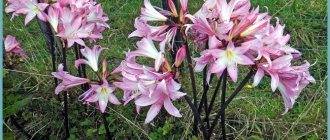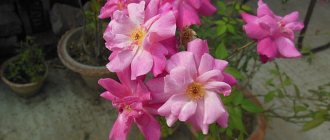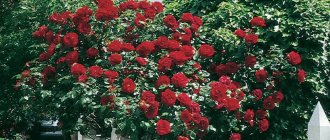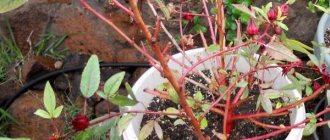Winter-hardy varieties of climbing roses
Nature has created amazing plants, and people strive to surround themselves with this splendor. And also comes up with new unusually beautiful variations. One of the most fascinating flowers is roses. Climbing roses that bloom all summer, winter-hardy varieties are perfect for growing near various supports, fences and arches. On the one hand, they resemble wild rose hips, and on the other, amazing specimens obtained after great effort, which attract not only their appearance, but also the pleasant aroma that fills the space around them.
Most of the varieties are represented by modern large-flowered roses. Flowering occurs in waves, and for some varieties it is almost continuous. They can reach two to three meters in height. Flowers cascade delicately from arches or arbors, creating a delightful view. They are perfect for transforming a backyard area, not only delighting the owner and others with their beauty, but also uplifting the mood. The buds have a wonderful aroma.
In order for roses to bloom for a long time, they require careful care. The plant will have to be tied up and directed in the right direction. Climbing roses that bloom all summer will be lush only if the requirements are met, then winter-hardy varieties will grow in comfortable conditions.
Important! For roses to be luxurious, they must be planted and cared for correctly.
Rose multiflora everblooming mini
Good day, dear readers! I think that there are very few people who are indifferent to the queen of flowers - the rose. I love this flower very much; in my garden there are more than 30 bushes of various roses. but I always dream of an indoor rose. Unfortunately, the indoor roses that I bought at the flower shop always quickly and inevitably die. I decided to grow miniature roses from seeds, because initially grown from seeds, they are better adapted to indoor keeping. I bought all kinds of seeds that were on sale. Today I will talk about the seeds of TM Aelita “Rose multiflora ever-blooming mini Garden aroma.”
On the back of the pack it is written that it can be grown in the garden and indoors, and brief recommendations on sowing and care are given.
I did not soak the seeds before sowing; I sowed them immediately dry from a bag. I took the soil based on coco soil and added a little perlite. The seeds were spread on the surface of the moist soil and sprinkled on top with a layer of about 5 mm. I covered the crops with film and placed them on the windowsill for germination. The seeds sprouted well, amicably and the seedlings came out strong. Here in the photo is a seedling after picking it into a separate glass.
and in this photo the seedling already has buds! The rose is truly multi-flowered, with 4-5 buds on one branch at once!
Here are the buds closer. After the photo shoot, I plucked them out and left only the central one. I plucked it out so as not to deplete the still young, fragile bush. When the bush gains mass and gets stronger, I will allow all the buds to grow.
And this is already my first rose blooming. as you can see, the flower is simple in shape, but this may be due to the fact that it is the first flowering and then the shape of the flower will change, I really hope so. By the way, the rose turned out to be very fragrant! With a subtle honey aroma! I am pleased.
Of course, I will recommend these seeds to all those who like to tinker and grow their favorite plant from the very beginning!!!
Multi-flowered ever-blooming mini rose - growing from seeds
Today, miniature rose bushes are very popular among gardeners - they are used for landscaping borders, balconies, grown in gardens, and sometimes in apartments. Among the numerous varieties of mini rose bushes, there are several plants that are especially easy to care for. For example, the multi-flowered ever-blooming rose mini Garden Aroma, growing from seeds is not associated with great difficulties. This variety attracts gardeners due to its delicate charm and long flowering. If you also love roses and want to grow this variety on your property, on this page “Popular about health” you will find valuable tips on growing and recommendations for caring for these roses. Multi-flowered rose - description What is this variety of flowers? The ever-blooming rose is a small shrub; it reaches a height of only about 30 cm. Its leaves are in most cases dark green, dense and small. All summer the rose bush blooms with beautiful delicate flowers in various shades of pink, red and cream. The diameter of the flowers does not exceed three centimeters. Gardeners decorate flower beds with them, place them in pots and containers, decorate their walls with compositions, and some even grow them on windowsills at home. The ever-blooming rose is unpretentious and undemanding. They love sun and warmth, prefer nutritious soil, and need protection from certain pests. In mid-latitude conditions, they need shelter for the winter, since this variety of mini roses does not tolerate temperatures that are too low (minimum -8). Some gardeners, when growing roses from seeds, encounter a problem - sometimes shoots simply do not appear. However, the mini rose germinates easily. If you want to admire the delicate inflorescences of miniature roses all summer, try growing them from seeds, and we will help you and give you some recommendations from experienced gardeners. Photo of the multi-flowered ever-blooming mini rose Garden Aroma
Olga Samoilova for Popular Health (www.rasteniya-lecarstvennie.ru)
Classification of winter-hardy roses
In addition to the division into varieties and varieties, the division is also carried out into groups. The systematization is as follows:
- First group. True roses have elastic shoots in the shape of an arc. Grows up to 5 meters. The spines are beautiful and thin. The flowering is rich and lasts about a month in the first part of summer. The foliage is small. Representatives are winter-hardy.
- Second group. Created by mixing remontant, tea and hybrid tea roses. The plants are interesting with strong growth up to four meters. They turned out with voluminous flowers and are distinguished by their second flowering. Resistance to cold, partial resistance to disease.
- Third group. Created by changing bush roses with voluminous flowering. They develop rapidly and bear fruit a little later. Bright colors.
Mrs. Herbert Stevens (Mrs. Herbert Stevens)
The advantage of this variety is that it blooms until frost. Bred by Mrs. Herbert Stevens was in 1910 and is still in demand due to its advantages:
- blooms even on infertile soil;
- cyclical flowering all season;
- grows to more than 5 meters in length.
Average resistance to disease, frost and rain makes this variety one of the most popular.
Climbing roses bloom all summer, winter-hardy varieties
There are two key characteristics by which the division occurs: small-flowered and large-flowered.
Roses with small flowers are called roses - Ramblers. Their difference is in thin and plastic shoots. They appear in early summer with small and primitive flowers. Flowering occurs once on last year's branches; this should be taken into account when pruning and covering.
Ramblers are quite unpretentious; they bloom all summer and are winter-hardy. These include:
- Bobby James. The best among small-flowered representatives. Up to eight meters in height, up to three meters in width. The foliage is green, but with abundant flowering it is practically invisible. Roses are creamy white, up to five centimeters. They emit a musky aroma. The variety is frost-resistant and disease resistant. Suitable for the Moscow region.
- Super Dorothy. Height up to 2.5 meters. The foliage is small. Late flowering, but rich and repeating. The variety is resistant to diseases, the flowers last until the onset of cold weather.
- Rambling Rector. It can reach more than seven meters in length. The color is pink, but gradually turns white. Roses are resistant to diseases and low light.
- Dortmund. Up to three meters long. The flowers are up to nine centimeters in size. The smell is not strong. Frost-resistant variety.
- Snow Goose. A sturdy and attractive creation. Height is more than three meters. The foliage is dark, with a small number of thorns. Flowers up to five centimeters, blooming all season almost uninterruptedly and abundantly. Resistance to diseases and frost.
Snow-Goose
The second group of Climings are climbing roses with strong, thick and hard shoots. Bred by crossing. Repeatedly, abundantly and for a long time blooming varieties on the shoots of the current year and previous years. The flowers are large and some have an intense aroma.
Claiming varieties:
- Michael (Orfeo). The buds have a chic dark color. The petals are velvety with a refined scent that becomes stronger in cool weather. The foliage is sparkling, dense, large. Resistant to diseases, but sensitive to rain. Flowering occurs continuously from June to October inclusive.
- Handel. The first re-blooming climber. With dark pink edging. The waviness of the flower adds sophistication. Inflorescences of 3-9 pieces are formed. Most beautiful when half-bloomed. Flowers are modified depending on weather conditions. Among roses, this variety has the most beautiful color contrast.
- Elf. Height up to 2.5 meters. Vigorous plant, large foliage. The flowers are greenish-white. Size up to fourteen centimeters. Fruity aroma. Resistant to rain and disease.
- Polka. A special rose. It is grown in two ways: as a low climber, or as a large, arched scrub. The buds are a concentrated apricot color, to creamy at the edges, the base is darker, which creates a play of colors. Flowering occurs repeatedly. Disease resistance. Variation in the appearance of roses depends on climatic conditions. It can reach three meters in height. The smell is not strong.
- Rimos. They have a colorful yellow color, turning lemon-colored in strong sun. Golden stamens are visible in the flower. Flowering is abundant and lasts until cold weather.
- Gloria Day Clyming. The flowers are yellow, not intense, with a pink edge. Up to 15 centimeters. The flowers have a weak, pleasant fruity aroma, solitary. Goblet shape. The plant can reach those meters. The foliage is dark and green. Flowering is medium, repeating. Winter-hardy.
- Golden Perfum. Rose with voluminous buds, twelve centimeters. Fragrant and rain resistant. They have a rich yellow color, enhanced by red stamens. The plant is branched, up to three meters. Flowering manages to repeat twice. This variety is one of the most famous among climbing roses. Flower in the shape of a cup. Flowers bloom slowly, making the owner happy for a long time.
- Parade. The variety is suitable for small-sized gardens. The flowers are large, concentrated pink or cherry red, cup-shaped, and the bushes are not particularly tall. Resistance to rain and frost is average. Rich repeat blooms.
- Schwanensee. A sought-after hardy variety, systematically flowering and resistant to rain. The flowers are voluminous, white with a slight pink tint. Looks great on a bush with bright green foliage. The buds have a standard appearance, elongated shape. The flowers open slowly. Diameter seven to eight centimeters. As a rule, there are no more than three of them per shoot. Flowers exude a delicate aroma. Flowering is long and repeated.
Varieties of semi-climbing cordes roses:
- Flamentanz. An actively blooming rose with a picturesque crimson color. Flowering occurs once, but can last up to thirty days. Diameter is about eight centimeters. Roses are found in inflorescences of three to sixteen pieces. Excellent winter hardiness is excellent for growing in Siberia. The plant is resistant to the most important diseases.
- Sympathy. Winter-hardy hybrid. Flowers with a tall glass, concentrated red color, with dark reflections. The first bloom is abundant, repeated blooms are weaker. The plant is resistant to rain, wind, and diseases. Up to four meters. The flowers are large and have a cup-shaped appearance.
- Westerland. The plant has strong disease resistance. The flowers are large, wavy. There are 5-10 pieces in brushes. Flowering begins early, but repeats itself. The foliage is elongated and dark. The bush is prickly. But the plant is beautiful.
Important! Regardless of the variety, any climbing roses require maximum attention, especially in the first year of cultivation.
The best varieties of climbing roses:
- Iceberg. One of the common types. The size of the flowers is up to eight centimeters. They bloom in inflorescences of three to eight pieces. The color is white, the aroma is subtle. Roses bloom all summer until late autumn. Excellent as a hedge.
- New Dawn. The size of the flowers is up to seven centimeters, in inflorescences of five to seven pieces. In rare cases, solitary. The color is soft pink, the aroma is not strong apple. Up to two meters high. Resistant to fungal diseases.
- Paul with Scarlett Clymer. Flowers up to seven centimeters. The color is concentrated red, the smell is slightly noticeable. Height is more than one and a half meters. Flowering occurs in the middle of the first summer month and lasts approximately for thirty days. After a short break, re-blooming begins. The plant is resistant to fungal diseases.
- Orange Morsdang. Low bushes, flowers up to five centimeters. Flowering is almost continuous. Does not tolerate rain well, has average resistance to diseases.
- Flamentanz. An unpretentious and winter-hardy rose. Rich flowering. Great resistance to diseases. In the first year the plant does not bloom.
There are many varieties. It is important to have an idea of their distinctive features, because this determines what the development needs will be and how to properly provide proper care, pruning, flowering, thorny or non-thorny plants.
During this time, the range of varietal roses has increased. Kordes are one of the best. They stand out for their special beauty and are characterized by abundant and long-lasting flowering. Excellent health and resistance to frost, easily overwinter.
Harkness are known everywhere. They are reliable in this they have no equal. Roses are unpretentious and easy to care for. Therefore, this is an ideal option for beginner gardeners. Repeated flowering, winter-hardy.
Roses from Tantau have appeared relatively recently. The plants are charming, bloom all summer, and tolerate rain well.
Climbing roses are in demand among gardeners. They have thin, long shoots that need support; they are irreplaceable for landscaping. Their sizes are not difficult to control and easily fit into different environments.
Kordes
Tantau
Chemical composition of rose scent
The chemical composition of the rose scent, in all its diversity, is extremely complex. Analysis of the fragrant essential oil extracted from the flowers of R. Damascena “Kazanlik”, the rose most widely grown for the production of fragrances in the perfume industry, shows at least 400 components. Modern science makes it possible to analyze odors in free space, when the aroma is just leaving the flower, giving a more accurate idea of its qualities. Hundreds of roses have been studied in this way, and although many details have not yet been published, it is clear that the total number of components found across the entire range of species and hybrids is significantly greater than the amount found in the “Kazanlik” rose.
old varieties of roses with a classic aroma “data-medium-file=”https://i1.wp.com/jenciklopedija-roz.ru/wp-content/uploads/2015/10/staryie-sorta-roz-s-klassicheskim- aromatom-1.jpg?fit=449%2C300&ssl=1″ data-large-file=”https://selo.live/wp-content/uploads/2020/11/pp_image_39274_uz0qhjraktstaryie-sorta-roz-s-klassicheskim-aromatom -1.jpg” class=”size-full wp-image-762″ src=”https://i1.wp.com/jenciklopedija-roz.ru/wp-content/uploads/2015/10/staryie-sorta- roz-s-klassicheskim-aromatom-1.jpg?resize=600%2C401″ alt=”old varieties of roses with a classic aroma” srcset=”https://i1.wp.com/jenciklopedija-roz.ru/wp-content /uploads/2015/10/staryie-sorta-roz-s-klassicheskim-aromatom-1.jpg?w=600&ssl=1 600w, https://i1.wp.com/jenciklopedija-roz.ru/wp-content/ uploads/2015/10/staryie-sorta-roz-s-klassicheskim-aromatom-1.jpg?resize=449%2C300&ssl=1 449w, https://i1.wp.com/jenciklopedija-roz.ru/wp-content /uploads/2015/10/staryie-sorta-roz-s-klassicheskim-aromatom-1.jpg?resize=200%2C134&ssl=1 200w” sizes=”(max-width: 600px) 100vw, 600px” data-recalc- dims=”1″ />old varieties of roses with a classic aroma
If we look at the composition of this rose in more detail, we will find that approximately 85% of the volume of aromatic oil includes only four components, another 10% contains approximately 10 components, and the remaining 5% oil includes more than a hundred elements. This type of composition is present not only in the scent of roses, but also in many other flowers, such as jasmine, narcissus, and lavender.
In the Gallic rose and the groups that descended from it, the main components are alcohols: phenylethyl alcohol, citronellol, geraniol and nerol, they are found in different proportions.
- Phenylethyl alcohol is more commonly found in the “soft” petals typical of light-colored Gallicas roses and is the main ingredient in natural rose water.
- Citronellol has a surprisingly warm and lively character, perhaps the most fragrant, and can be “heard” in some Rugosa hybrids, for example, in “Blanc de Coubert”.
- Geraniol is similar to citronella, but has a sharper character, reminiscent of the scent of geranium leaves.
- Nerol is harsher, but also the freshest.
All these components are widely used in the perfume industry, creating a special rainbow character when mixed. Together they form a base with the typical aroma of European “Old Rose” roses and Rugosas roses. Alcohols themselves give a bad aroma, because they must be complemented by hundreds of other materials, many of which are quite “quiet”, and some of them, on the contrary, are very powerful. Proper mixing provides individuality, depth and strength of smell.
Climbing roses planting and care in the Moscow region, the Urals, Siberia
Roses love light, and elevated southern locations suit them. Good lighting ensures rapid development of growth, and flowering can be expected next season. You cannot plant seedlings in lowlands; these flowers do not tolerate moisture well.
Know! When climbing roses serve to decorate an object, they should be planted half a meter away from it.
They should be planted in the spring, since in the fall they may not have time to adapt, and there is a high probability of their death. They do not have to allocate large areas; fifty centimeters is enough. The size of the holes is 50 x 50 cm. The prepared holes are watered before planting. After completing the process, the above-ground part must be cut to 15-20 cm. This is done for rapid growth and rich flowering in the future.
If you still choose autumn for planting, then this should be done at the end of September. Roses should have time to take root, but the buds should not begin to grow.
Next season, the plant no longer requires such careful and constant care. It is enough to trim the bushes in a timely manner, properly water and fertilize. Pruning is done to shape the bush and thin it out. Watering flowers should be once every seven to ten days. Organic matter, minerals and other fertilizers are suitable as fertilizers.
Plant plants at an angle of thirty degrees to the support. When planting near the house, it is necessary to maintain a distance from the wall so that running water does not fall on the roots. When tilted, the plant stays more stable in the ground. A rose near a wall may lack moisture.
Important! Climbing roses develop better in the sun; it is not recommended to plant them in the shade.
Landing
Sowing seeds for seedlings begins in March. The seeds are placed in prepared soil, watered, and covered with transparent material. After 2-3 weeks, the first shoots appear.
After the first shoots appear, you need to place the container with the seedlings in a sunny, warm place. When the sprouts reach a height of 10–15 cm, you need to transplant the seedlings to a permanent place.
Multi-flowered roses can be planted in open ground, in pots, containers, and cache-pots.
Before planting seedlings, it is necessary to prepare the soil. The following is added to the soil for growing roses:
- Humus - 2 parts;
- Garden soil - 2 parts;
- Wood ash – 1 part;
- Complex of mineral fertilizers - according to the instructions.
If the flowers will be grown in pots, you can add perlite to the soil. Planting in pots can be done at any time.
Planting in open ground begins when warm weather sets in; it is advisable to cover the seedlings at night.
Pruning climbing roses
This stage allows you to form the crown and make the plant more powerful. Decorative effect is added through this process.
Proper care gives a significant increase in young shoots per season. It is recommended to cover the plant for the winter due to severe frosts. When spring comes, only dead, frozen parts should be pruned.
Long shoots should be spread on the ground so that replacement shoots can be seen. They can be tied to supports only after they have grown to seventy centimeters.
Pruning differs depending on the group the plants belong to. The old shoot has to be replaced with several fresh ones. Therefore, there should be 3-5 annual and the same number of two-year branches.
If roses are those that bloom twice in one passing season, then flowering shoots can be on the branches of the bush for 3 years. Only after five years does it begin to weaken.
Significant shoots are eliminated only in the fourth year. If there are a lot of young animals at the base, then circumcision can be done in the same way as with the first group.
Important: When pruning, you should pay attention to vegetative shoots, because the main flowering of the bush occurs on last year’s stems. Young shoots should also be removed so that they do not thicken the bush and interfere with the full development of the plant.
Guirlande d'Amour
Among other varieties, this one is the most atypical because of its buds. Small flowers with petals turned outward intertwine with each other and form bouquets throughout the bush.
Standard tomatoes: 8 varieties that will delight you with the taste and abundance of the harvest
An unusual frost-resistant variety, in comparison with the previous one, it is even more resistant to diseases, heat and rain.
Advantages:
- strong musky aroma with spicy notes:
- continuous flowering throughout the season;
- spreading and tall bush, growing up to 3 and a half meters.
Guirlande d'Amour is more picky about soil than other varieties, but otherwise has no drawbacks.
Preparing climbing roses for winter
Climbing roses are winter-hardy plants, but despite this, some varieties need to be covered. Therefore, it is important that plants that bloom all summer are properly protected. There must be an air gap under the shelter. Otherwise, the bushes will die not from frost, but from getting wet or damping off.
Preparations for winter begin at the end of August. The soil is loosened, watered and fertilized. It is necessary to cover for the winter when the frost is about minus five degrees. A little frost will only strengthen it before the onset of severe cold; you cannot cover it before it arrives.
Roses need to be prepared in dry weather. Plants are removed, foliage is removed, damaged areas are cut off. After this, the lashes are tied and pressed to the ground with special devices.
Important! You cannot cover roses ahead of time, as they will die.
Features of care
It is advisable to water roses with melt or rain water at least once a week. In summer, the water is kept in the sun in large containers. After watering, the soil between the rows is loosened, mulched with peat and dry grass. Dallas rose bushes need hilling. This procedure will protect the lower buds from heat and cold.
In young seedlings, the first buds are broken off so that the plant has the opportunity to fully develop. For cutting into a bouquet, take no more than two flowers from one bush. The intense flowering regime of the Dallas variety requires several feedings per season. In the spring, nitrogen fertilizers (slurry, bird droppings) are used, in the summer they include phosphorus additives in the complex, and in the fall they add potassium fertilizers.
They form a bush by cutting shoots to a height of 5-8 buds to stimulate the formation of annual flower stalks. Pruning is carried out in the spring, and damaged and dried branches are removed.
In summer and autumn, blind shoots (non-flowering), wild young shoots, and immature buds are removed. This entire mass is burned to prevent infectious infections and parasite attacks. To prevent diseases, spray with a soap-soda solution.
Propagation of climbing roses from cuttings
Roses reproduce well by green cuttings, which accelerates almost 100%. Winter or summer cuttings can be selected for these purposes, and propagation begins in the second half of June.
The material is harvested only from healthy shoots, with several internodes, with an oblique cut at the bottom. The leaves from the bottom are carefully removed, the remaining ones are trimmed. The finished material is placed in a specially prepared mixture of sand and earth to a depth of one centimeter. A box, pot, etc. is suitable for the container. In it, the workpiece is covered and slightly shaded.
The watering regime is relaxed; it is not necessary to add growth agents. Before placing the cutting under the covering, you can treat it with a solution of alcohol or heteroauxin.
Only some varieties from the group of large-flowered ones are propagated by budding. This is done in August - September by placing a dormant eye into the root collar of one or two year old rose hips.
Growing from seeds in the garden
Growing roses from seeds can also be done in a garden, bypassing the difficult interaction with the refrigerator and bags. Experienced plant growers most often do just this - of course, after preliminary disinfection with peroxide. In this case, sowing is carried out in August, and the stratification itself takes place under natural conditions, until the beginning of spring. The landing technique is as follows:
- a shallow trench is being prepared, without deepening;
- the soil is loosened and fertilized before planting;
- the material is carefully sprinkled with earth to the extent of half a centimeter;
- if autumn is dry, the sowing area is sprayed;
- A small shelter is placed on top: this will preserve moisture in the upper layers of the earth.
When living in winter cold conditions, you should take care of shelter. Leaves, straw, spunbond are used, and the arrangement is lightly sprinkled with loose snow on top. In April, the structure can already be removed, and if there is a chance of frost in the spring, a small polyethylene greenhouse is installed above the trench.
Application options for climbing roses
In home gardens, climbing roses are used for various purposes. Plants are suitable as unusual garlands and pyramids, for creating an arch of climbing roses or for decorating a gazebo. It will also look great when landscaping an arbor, fence or column and many other buildings. Roses will help create a gorgeous look.
There are also other, original options for using these plants. If you plant climbing roses near trees or strong bushes, then in the near future they will begin to use them as a support. In such situations, careful care and pruning are required. In addition, the tree can easily overcome such a neighborhood, and the bushes may die. Before using a plant as a support, you should make a thoughtful decision.
Important! You should choose the right support for a climbing rose.
How to grow seeds from China
Even if the material turns out to be of not very high quality, with such a quantity, at least part of it will sprout, and this is already very good - especially since you will have to pay a minimal price for it.
The growing process has already been described in detail in the previous paragraphs, and is not affected in any way by the country in which it was produced or collected. Processing and stratification are also carried out (either in the refrigerator or in the garden).
The only point: when purchasing, it would not hurt to clarify whether preliminary disinfection has already been carried out. If not, treat with peroxide, and if it has already been done, you can safely start growing.
Pests and diseases of climbing roses
Powdery mildew. This disease is caused by a fungus. It appears on the leaves in the form of white spots that increase over time. Forms well in hot and humid conditions in late summer. The plant itself stops growing and stops blooming. Which could ultimately lead to his death. To prevent the disease, experts recommend spraying the bushes with Bordeaux solution.
Conitirium - bark cancer. Symptoms when releasing bushes from winter shelter. Red-brown spots appear on the bark; as they grow, they begin to turn black and can cover the entire shoot. The infection is located internally, so infected shoots must be quickly cut out, including healthy shoots, and then immediately burned.
This mushroom grows quickly in the dark under cover. As a preventive measure, nitrogen levels are reduced in the fall, tissue feeding, shelter at the appropriate time and ventilation when necessary, and material removal. Removal and extermination of damaged areas. In addition to them, the plant can be affected by aphids and spider mites.
Polka 91
Unusual roses of this variety are characterized by a deep peach shade of dissimilar flowers with wavy petals along the edge. The brush consists of 1-3 flowers. Despite their fragile appearance, the bushes grow up to 2.5 m in height and are frost-resistant and immune to disease. These roses are ideal for landscaping walls and vertical structures. Flowering occurs three times in warm climates, and at least twice per season in cold climates. The petals do not fall off even during heavy rain and retain their shape for many days.
Which variety of climbing rose to buy
When choosing roses for planting, it is important to choose them correctly. To buy exactly the varieties that you would like, you can look at them in the photo for clarity; there are a large number of them on the Internet. This way, it will be easier to decide on the type of flower. You can choose an unpretentious look that requires minimal attention. Or, on the contrary, one that constantly needs to be dealt with.
By acquiring such a wonderful plant, the owner will enjoy extraordinary beauty throughout the summer season, and climbing roses can be used to decorate various objects, which makes it even more attractive.
The main thing to remember is that the plant requires care to achieve maximum results. Namely, proper planting, timely fertilizing and watering, and other equally necessary actions. And of course, carrying out preventive measures to combat pests and diseases.
A little history
Around the 12th century, the first examples of Asian roses appeared in Europe, with which breeders began to work. Since that time, the number of species of the queen of flowers began to increase extremely rapidly. Breeders improved the original samples, giving them the abilities necessary for the European climate, including winter hardiness.
Thanks to their species diversity and relative ease of care, roses grew well both in open ground and indoors, thereby gaining fame as the most popular flower.
Miniature roses owe their appearance to China. They were brought to Europe in 1810, but received widespread recognition only more than a century later.
Spanish and Dutch botanists began breeding new varieties only in 1940. Breeding scientists created new hybrids using other low-growing roses. Thanks to their work, a variety of varieties of miniature roses with bright colors and graceful flower shapes were obtained.











